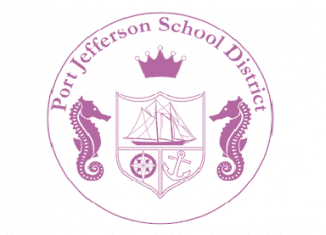Capital bonds: PJSD nears historic referendum over school infrastructure
Port Jefferson School District residents are confronting a major public referendum on Monday, Dec. 12.
Earlier this month, the district’s board of education passed two resolutions to put the combined $25 million in capital bonds projects out for a public vote.
Now district officials are making their pitch to the general public, with three bond tours scheduled for October and November. Approaching this weighty decision, the community is evaluating its options.
Proposition 1Highlights
- Capital bonds vote to be held Monday, Dec. 12
- Proponents of Proposition 1 say facilities improvements are necessary to draw families into the district and maintain property values
- Critics question the environmental risks and cost effectiveness of artificial turf in Proposition 2, district stands by the measure
The lion’s share of the two ballot measures will go toward Proposition 1, a $23.1 million infrastructure package to modernize the district’s aging and outdated facilities. Such improvements target heating and ventilation systems, renovations to the locker rooms and team rooms, and relocation of art, technology and music rooms, among other reconfigurations.
In an email statement from Jessica Schmettan, superintendent of schools, she outlined how infrastructure improvements will help the district meet its academic standards.
“Many of the existing items are original to the buildings, most dating back to the 1960s,” she said. “Our mission in Port Jefferson has always been focused on academic rigor and personalized instruction for all students. … In order to focus on these areas, we need to modernize and renovate aging facilities.”
Mayor Margot Garant expressed support for these investments. For her, it is prudent to invest now while district taxpayers are still subsidized by the Long Island Power Authority.
“We are in a position right now where we have five years left on our glide path,” Garant said, referring to the gradual decline of LIPA subsidies in the coming years. “For every dollar that we spend, LIPA is still picking up 50 cents on that dollar. These facilities need to be protected, and they need to be invested in.” The mayor added, “If we don’t make those investments, that’s going to start to have impacts on property values and on whether people want to come and live here.”
New York State Assemblyman Steve Englebright (D-Setauket) has followed the matter closely. In an exclusive interview, he likened investments in school facilities to an oil change on a car: Residents can either pay now or pay in the long term.
“I think the mayor is right,” Englebright said. “This is a moment. If you miss that moment, then the buildings deteriorate and they become less appropriate for the next generation of students going into them.” He added failing to recognize these needs is “short-sighted thinking.”
Proposition 2‘There is still an open question as to whether these artificial fields are a) without biohazards and b) cost effective.’
— Steve Englebright
The second ballot measure varies widely from the first in terms of scope and cost. It has also drawn significantly more opposition from the public and even members of the Board of Education.
Proposition 2 concerns the $1.9 million proposed crumb-rubber artificial turf field for athletic competitions. This proposal also comes with continual costs for replacement every eight-to-12 years, a sticking point for some.
Paul Ryan, a district resident and former BOE candidate in 2022, is among the most vocal opponents of this measure. “My position on Prop 2 is that it is financially irresponsible in this economic climate of high inflation,” he said. “It’s a heat sink and will fill our harbor with microplastics, less safe than grass and less enjoyable for most of our community to play on.” He added that the process to put out the turf field for public referendum was “conducted in an ethically dubious manner.”
Ryan is not the only one against the turf field proposal. During a special meeting of the BOE on Tuesday, Sept. 13, numerous other residents raised objections to Prop 2 on similar grounds.
Citing the potential for environmental or ecological harm, Englebright, a geologist by training, expressed in his interview reservations about using artificial turf.
“The underpinnings of the artificial turf is rubber, and it usually comes from waste tires,” he said. “That has proven to be a source of contamination.” The state assemblyman added, “In the universal sense — I don’t mean specifically for this school district — there is still an open question as to whether these artificial fields are a) without biohazards and b) cost effective.”
On the other hand, during the Sept. 13 meeting, many parents and students showed support for the turf proposal, contending that it would foster school pride and bolster a sense of community identity.
Regardless of the mixed reaction, the school district remains supportive of Proposition 2. “The district is equally supporting both propositions on the ballot that represent a variety of needs,” Schmettan said.
Long-term uncertainty
During this year’s trustee election for the Board of Education, candidates debated the topics of declining student enrollment and the chance that PJSD will merge with another school district in the coming years. [See “Port Jeff BOE candidates tackle the issues,” The Port Times Record, May 12.]
Though these debates remain unsettled, Schmettan holds that the capital bonds will help draw families into the district while meeting its academic aims.
“There is no doubt districts across Suffolk County are experiencing a decline in student enrollment,” she said. “However, merging with another school district erases our unique opportunities and increases school tax rates.” The superintendent concluded, “We need to improve facilities to match our outstanding academic programs and explore ways to attract families with children to the area.”
Garant spoke in similar terms. She believes Port Jefferson remains a desirable location to raise a family. However, preserving a high standard of living and quality public schools comes at a price.
“When you go for a bond initiative, it’s a project of significant proportions,” the mayor said. “I’d rather see us make an investment and secure the quality of life that we have. And that will be up to the voters.”







